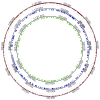Whole genome sequence of the Treponema pallidum subsp. endemicum strain Bosnia A: the genome is related to yaws treponemes but contains few loci similar to syphilis treponemes
- PMID: 25375929
- PMCID: PMC4222731
- DOI: 10.1371/journal.pntd.0003261
Whole genome sequence of the Treponema pallidum subsp. endemicum strain Bosnia A: the genome is related to yaws treponemes but contains few loci similar to syphilis treponemes
Abstract
Background: T. pallidum subsp. endemicum (TEN) is the causative agent of bejel (also known as endemic syphilis). Clinical symptoms of syphilis and bejel are overlapping and the epidemiological context is important for correct diagnosis of both diseases. In contrast to syphilis, caused by T. pallidum subsp. pallidum (TPA), TEN infections are usually spread by direct contact or contaminated utensils rather than by sexual contact. Bejel is most often seen in western Africa and in the Middle East. The strain Bosnia A was isolated in 1950 in Bosnia, southern Europe.
Methodology/principal findings: The complete genome of the Bosnia A strain was amplified and sequenced using the pooled segment genome sequencing (PSGS) method and a combination of three next-generation sequencing techniques (SOLiD, Roche 454, and Illumina). Using this approach, a total combined average genome coverage of 513× was achieved. The size of the Bosnia A genome was found to be 1,137,653 bp, i.e. 1.6-2.8 kbp shorter than any previously published genomes of uncultivable pathogenic treponemes. Conserved gene synteny was found in the Bosnia A genome compared to other sequenced syphilis and yaws treponemes. The TEN Bosnia A genome was distinct but very similar to the genome of yaws-causing T. pallidum subsp. pertenue (TPE) strains. Interestingly, the TEN Bosnia A genome was found to contain several sequences, which so far, have been uniquely identified only in syphilis treponemes.
Conclusions/significance: The genome of TEN Bosnia A contains several sequences thought to be unique to TPA strains; these sequences very likely represent remnants of recombination events during the evolution of TEN treponemes. This finding emphasizes a possible role of repeated horizontal gene transfer between treponemal subspecies in shaping the Bosnia A genome.
Conflict of interest statement
The authors have declared that no competing interests exist.
Figures



Similar articles
-
Whole genome sequence of the Treponema pallidum subsp. endemicum strain Iraq B: A subpopulation of bejel treponemes contains full-length tprF and tprG genes similar to those present in T. p. subsp. pertenue strains.PLoS One. 2020 Apr 1;15(4):e0230926. doi: 10.1371/journal.pone.0230926. eCollection 2020. PLoS One. 2020. PMID: 32236138 Free PMC article.
-
Human Treponema pallidum 11q/j isolate belongs to subsp. endemicum but contains two loci with a sequence in TP0548 and TP0488 similar to subsp. pertenue and subsp. pallidum, respectively.PLoS Negl Trop Dis. 2017 Mar 6;11(3):e0005434. doi: 10.1371/journal.pntd.0005434. eCollection 2017 Mar. PLoS Negl Trop Dis. 2017. PMID: 28263990 Free PMC article.
-
Whole genome sequences of three Treponema pallidum ssp. pertenue strains: yaws and syphilis treponemes differ in less than 0.2% of the genome sequence.PLoS Negl Trop Dis. 2012 Jan;6(1):e1471. doi: 10.1371/journal.pntd.0001471. Epub 2012 Jan 24. PLoS Negl Trop Dis. 2012. PMID: 22292095 Free PMC article.
-
Genetic diversity in Treponema pallidum: implications for pathogenesis, evolution and molecular diagnostics of syphilis and yaws.Infect Genet Evol. 2012 Mar;12(2):191-202. doi: 10.1016/j.meegid.2011.12.001. Epub 2011 Dec 15. Infect Genet Evol. 2012. PMID: 22198325 Free PMC article. Review.
-
Genetics of human and animal uncultivable treponemal pathogens.Infect Genet Evol. 2018 Jul;61:92-107. doi: 10.1016/j.meegid.2018.03.015. Epub 2018 Mar 22. Infect Genet Evol. 2018. PMID: 29578082 Review.
Cited by
-
Tracing the origin of Treponema pallidum in China using next-generation sequencing.Oncotarget. 2016 Jul 12;7(28):42904-42918. doi: 10.18632/oncotarget.10154. Oncotarget. 2016. PMID: 27344187 Free PMC article.
-
Sequencing of Treponema pallidum subsp. pallidum from isolate UZ1974 using Anti-Treponemal Antibodies Enrichment: First complete whole genome sequence obtained directly from human clinical material.PLoS One. 2018 Aug 21;13(8):e0202619. doi: 10.1371/journal.pone.0202619. eCollection 2018. PLoS One. 2018. PMID: 30130365 Free PMC article.
-
Whole genome sequence of the Treponema pallidum subsp. endemicum strain Iraq B: A subpopulation of bejel treponemes contains full-length tprF and tprG genes similar to those present in T. p. subsp. pertenue strains.PLoS One. 2020 Apr 1;15(4):e0230926. doi: 10.1371/journal.pone.0230926. eCollection 2020. PLoS One. 2020. PMID: 32236138 Free PMC article.
-
Complete genome sequences of two strains of Treponema pallidum subsp. pertenue from Indonesia: Modular structure of several treponemal genes.PLoS Negl Trop Dis. 2018 Oct 10;12(10):e0006867. doi: 10.1371/journal.pntd.0006867. eCollection 2018 Oct. PLoS Negl Trop Dis. 2018. PMID: 30303967 Free PMC article.
-
Comparative genomics of the transportome of Ten Treponema species.Microb Pathog. 2019 Jul;132:87-99. doi: 10.1016/j.micpath.2019.04.034. Epub 2019 Apr 25. Microb Pathog. 2019. PMID: 31029716 Free PMC article.
References
-
- Perine PL, Hopkins DR, Niemel PLA, St. John RK, Causse G, et al... (1984) Handbook of endemic treponematoses: yaws, endemic syphilis, and pinta. Geneva: World Health Organization.
Publication types
MeSH terms
Associated data
- Actions
LinkOut - more resources
Full Text Sources
Other Literature Sources
Medical
Molecular Biology Databases

